Washington, D.C. a Family Adventure - Day 1
Capitol Hill 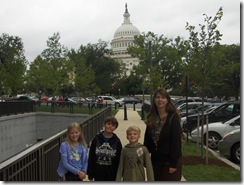 -- Our first morning in Washington, D.C.
-- Our first morning in Washington, D.C.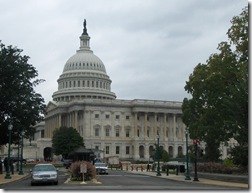
Our Hotel is only about 3 blocks from Capitol Hill. Here we are on our way to see as much as we can of the city.
We were needing to eat breakfast and there is not a fast food place or restaurant in sight. We ask a policeman as we cross the street if there is somewhere close by to eat. He points to this Senate Building and says there is a Cafeteria in the basement.
We entered the building and immediately had to go through Security check. Just like the airport. All bags are sent through the x-ray and everyone walks through the scanner one at a time. We find our way downstairs and it is a very nice cafeteria.
The Supreme Court Building
This shows how huge the columns are. Photo by Derek.
photo by Derek of the 9 chairs and desk/podium the Supreme Justices sit behind.
In front of that are all the smaller chairs and then the heavy red curtains are just in front of us and the doorway. This is as close as we were able to get.
Library of Congress and the fountain out in front.
and the Battle memorial statues on either side of him.
The National Archives
Inside the National Archives there is no flash allowed and the lighting is very dim.
My camera just can't do that, so this is the best picture I could get of the Rotunda with the
Declaration of Independence, The Bill of Rights and the Constitution.
They are very faded and difficult to see in the dim room and under the safety glass.
Of course -- me trying to figure out my camera and trying different settings manages to use my flash on accident and the guards are all over you if you do. If it happens twice they say they will take your camera away from you. SO I put mine away.
I had turned off the flash, but then changed to "night portrait" and didn't see that that turns the flash back on and so I got this picture of the painting on the wall with George Washington in the center of the men dressed in white and blue.
 In The National Archives building we watch a wonderful video that tells What kind and How much information is stored there. You can research your family history there and see documents about your ancestors and possibly forms that they may have filled out. There are consensus records there.
In The National Archives building we watch a wonderful video that tells What kind and How much information is stored there. You can research your family history there and see documents about your ancestors and possibly forms that they may have filled out. There are consensus records there.
We are still in the Art Sculpture Garden and my photo is of both the Sculpture and the National Archives Building.Mark di Suvero, American, born 1933, Aurora, 1992-1993 - steel.
National Gallery of Art Sculpture Garden
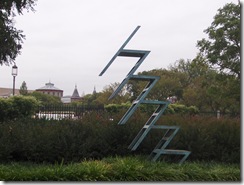 Chair Transformation Number 20B, 1996,
Chair Transformation Number 20B, 1996,
by Lucas Samaras (American, born 1936, Greece).
The work, depicting an animated flight of stacked chairs, belongs to a series in which the artist represents the chair in a variety of guises and materials, including wire mesh, wood, string, and mirrored glass. The fantastical composition evokes a hallucinatory realm, in which the object appears to lean back and spring forth at the same time.
Four-Sided Pyramid. first installation 1997, by Sol LeWitt (American, born 1928).
The terraced pyramid, first employed by LeWitt during the 1960s, relates to the setback design that has long been characteristic of New York skyscrapers. This geometric structure also alludes to the ancient ziggurat form of Assyrian and Babylonian temples.
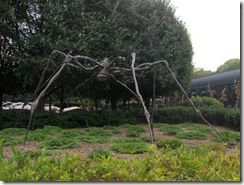 We were a little scared by this giant spider.
We were a little scared by this giant spider.
Spider. 1996, cast 1998, by Louise Bourgeois (American, born 1911, France).
The ten-foot-by-twenty-four-foot bronze cast with a silver nitrate patina depicts the spider as a looming and powerful protectress who is also nurturing and vulnerable. Belonging to Bourgeois' Spider series, which explores themes of childhood memory and loss.
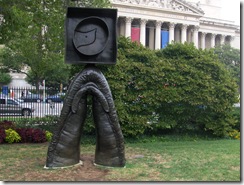 by Joan Miro. Personnage Gothique, Oiseau-Eclair (Gothic Personage, Bird-Flash)
by Joan Miro. Personnage Gothique, Oiseau-Eclair (Gothic Personage, Bird-Flash)
The is one has some doves and a donkey yoke.
It is one of Miró's largest sculptures, a bird was cast from an object the artist created, while the head was cast from a cardboard box and the body from a donkey yoke. Through the juxtaposition of disparate objects, surrealist artists sought to evoke surprise. Read more at the Sculpture Garden website.
The kids thought this was a Giant Pizza Cutter.
We had to explain several times that it was an eraser, used with typewriters..... what's a typewriter???
Typewriter Eraser. Scale X, 1999, by Claes Oldenburg (American, born 1929, Sweden) and Coosje van Bruggen (American, born 1942, The Netherlands).
The typewriter eraser, one of Oldenburg's favorite childhood playthings from his father's office, is an image he first used in the 1960s and 1970s as a source for drawings, prints, and sculpture.
Barry Flanagan
British, born 1941
Thinker on a Rock, 1997 cast bronze
 Our first Hot Dog and Pretzel from a cart on our trip.
Our first Hot Dog and Pretzel from a cart on our trip.
The first of Many!
The Washington Monument
Tickets to go up into the monument are given out starting at 8 a.m. on first come first served basis for timed entry. Everything I read warned that they run out of tickets quick! So I ordered our tickets for 3:00 p.m. online. I had to pay a service fee of $1.25 each but it was worth the peace of mind. It also kept us moving on a tight schedule. The National Parks website is where you get tickets. When we picked up our tickets at will call they had tickets for that day for 3:00 on.
As you can see it was a very windy, rainy day and there were not very many people out sight seeing and visiting the Mall.
The Park Ranger told everyone to look around the corner at the statue of Washington and said it was special because it was made of Chocolate.... the kids believed him for a while.
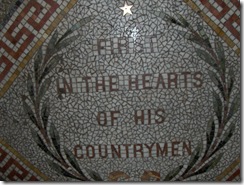 The elevator ride is quick and the view is amazing.... even in the pouring rain when the windows are covered with raindrops.
The elevator ride is quick and the view is amazing.... even in the pouring rain when the windows are covered with raindrops.
The rest of the trip the kids all said that going up in the Washington Monument was their favorite thing. (Mine will be Mt. Vernon, Geoff's favorite was the Supreme Court earlier today)
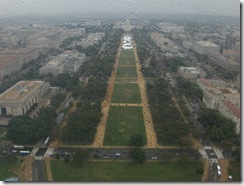 The view out of the window towards Capitol Hill. The white spots in the middle are tents set up for The National Mall to become an open-air library on Saturday for the National Book Festival, co-hosted by First Librarian Laura Bush and the Library of Congress.
The view out of the window towards Capitol Hill. The white spots in the middle are tents set up for The National Mall to become an open-air library on Saturday for the National Book Festival, co-hosted by First Librarian Laura Bush and the Library of Congress.
Here's the view from the other 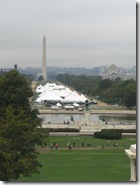 direction.
direction.
WWII memorial, reflecting pool & Lincoln Memorial
Jefferson Memorial & Pentagon (below)
The walls of the W. Monument are built from thick to thin. At the top, where the windows are, the walls are only 7 inches thick. You can see where they cut out the holes, and see the holes, where the red airplane warning lights are placed and constantly blinking. Here is a piece of a wall. The brown piece leaning to the side is a sample of the "cloth" used between bricks. I think the ranger said that no cement or mortar was used just this thick cloth.
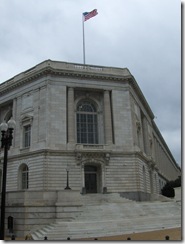
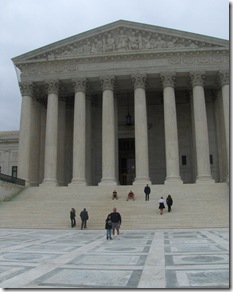
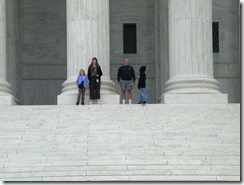
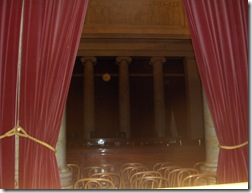
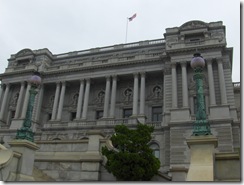


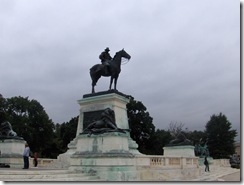

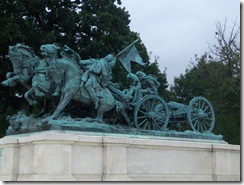
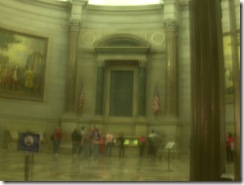
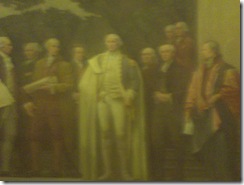
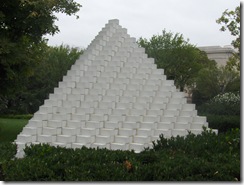
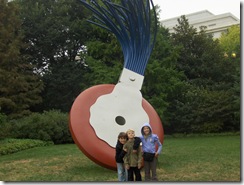
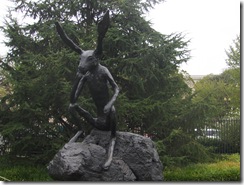
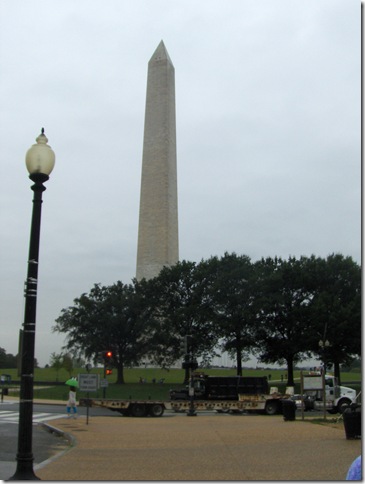
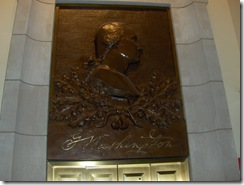
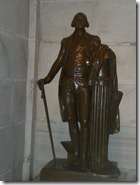
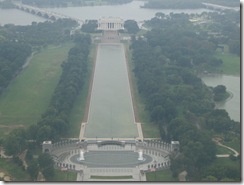
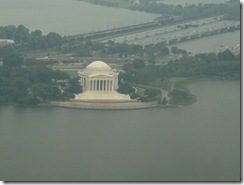

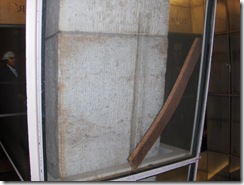

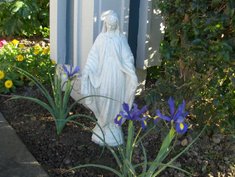

No comments:
Post a Comment